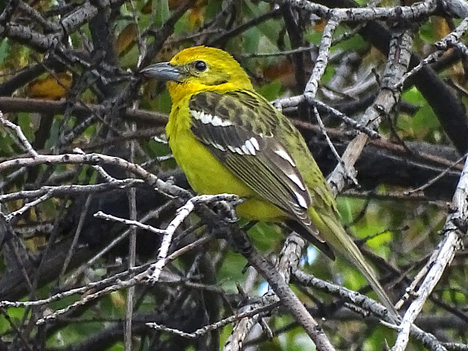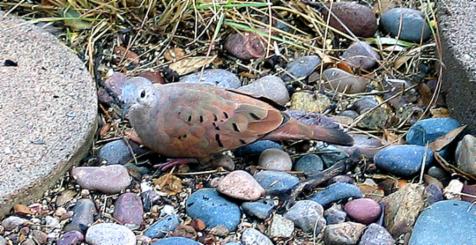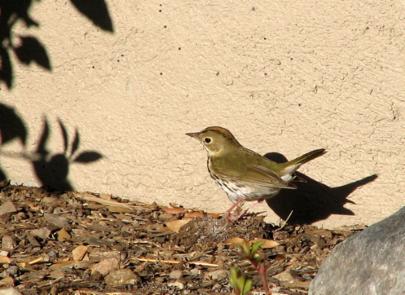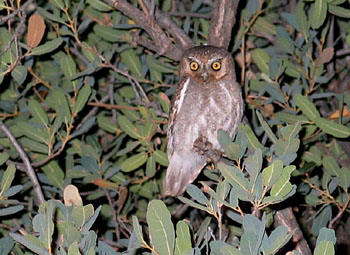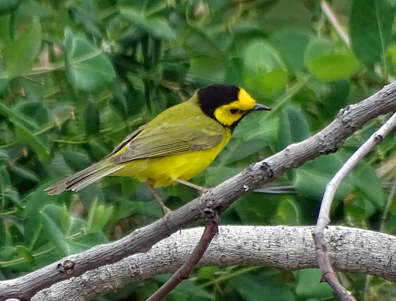
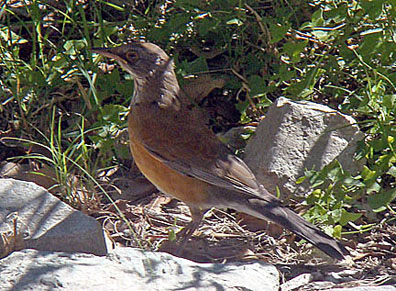
One of the nicer additions to the yard list, this Rufous-backed Robin (a stray from western Mexico but now a rare nester in Arizona) showed up 10 October 2012 and stayed for three days.
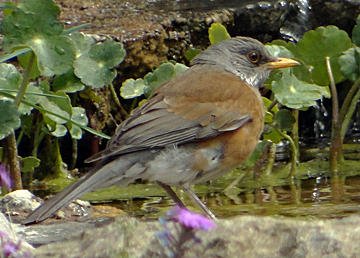
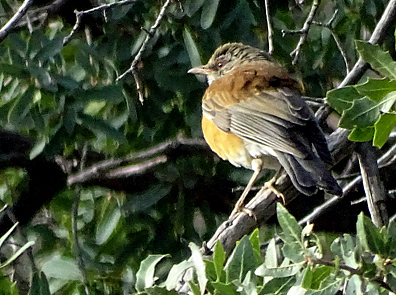
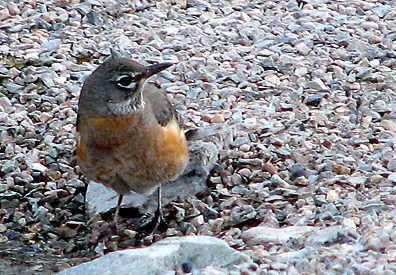
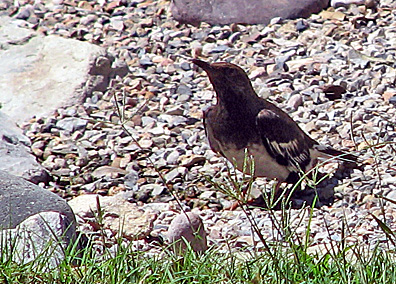
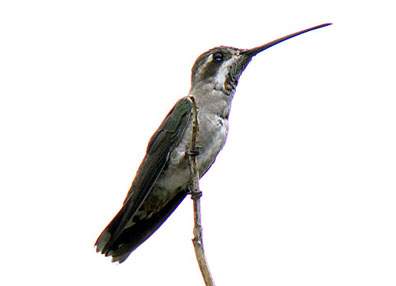
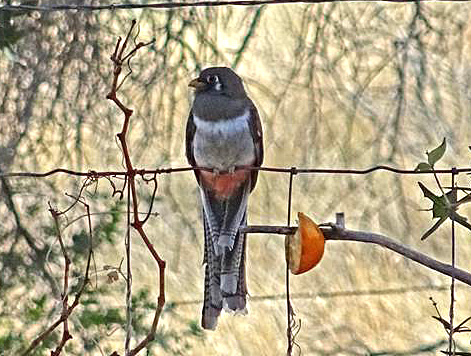
All I had to do was leave the country to make an Elegant Trogon show up in the back yard. This winter wanderer visited on two days (Karen LeMay photo: 27 February 2016).
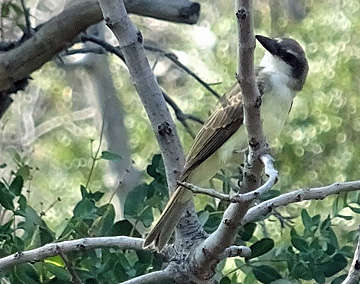
Karen grabbed a shot of this surprising visitor, a Thick-billed Kingbird that briefly visited the pond area on 15 September 2020.
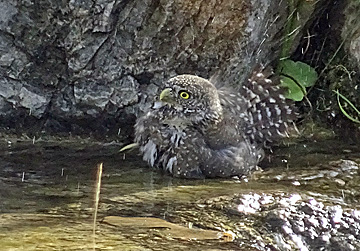
A Northern (Mountain) Pygmy-Owl taking a mid-day bath in our pond (23 December 2017).
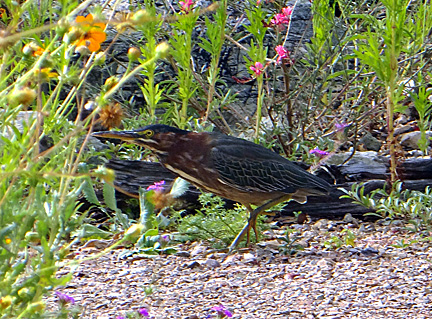
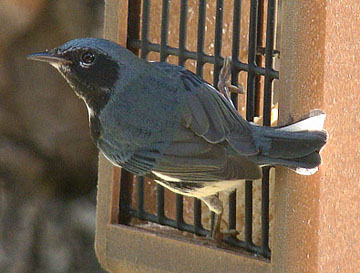
This male Black-throated Blue Warbler stayed for a week during late October 2010. Within a few days, it was visiting our suet feeders (23 October 2010).
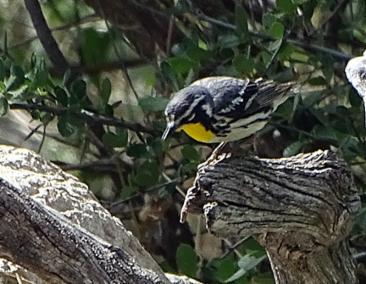
A locally rare Yellow-throated Warbler that appeared at the pond (17 May 2016).
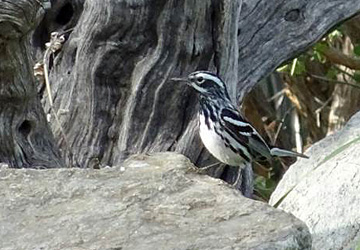
Karen photographed this male Black-and-white Warbler at the pond on International Migratory Bird Day (14 May 2016).
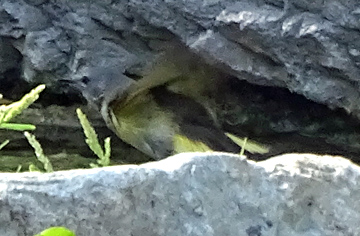
An American Redstart (the second for the yard) took a bath in a sprinkler a few feet from Karen, then dropped in at the pond for only two or three seconds (22 June 2017).
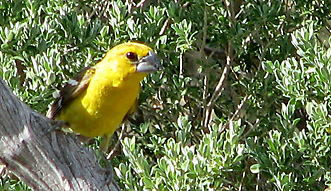
Quite a rarity in the U.S., this male Yellow Grosbeak showed up several times at the backyard pond during two consecutive days (2 June 2007).
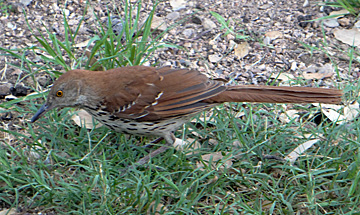
Brown Thrasher is an uncommon visitor from the eastern U.S. This individual (the second for the yard) appeared 28 April 2014 and remained for several days (30 April 2014). A third individual visited us on 16 December 2016, the day of the local Christmas Bird Count.
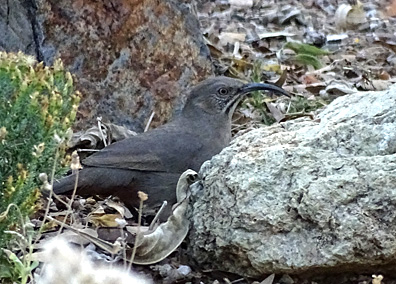
A Crissal Thrasher Karen found on 5 November 2020 was a nice respite from the angst of the presidential election. After foraging in gravel for an hour and a half or so, it was chased off by a territorial Curve-billed Thrasher.
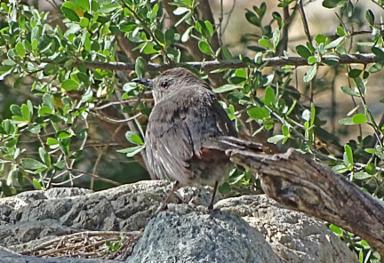
A Gray Catbird, rather rare in SE Arizona and our only record for the yard, showed up at the pond several times for a quick dip (18 May 2016).

Noisy and easily seen, Curve-billed Thrasher occurs daily, occasionally nesting in the yard's cactus clumps. This one appeared to be checking out our cat that was sitting in the kitchen window (7 November 2020).
Always a nice bird to see north of the Mexican border, this male Ruddy Ground-Dove (one of two present) was photographed from the kitchen window (27 January 2005). Another was present during the second week of November 2020.
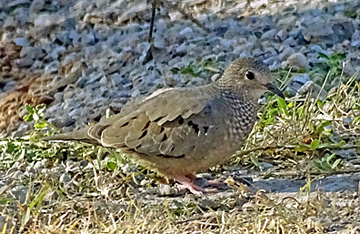
A Common Ground-Dove, not so common in our yard, exhibits the distinctive speckling on the breast and nape (22 October 2020).
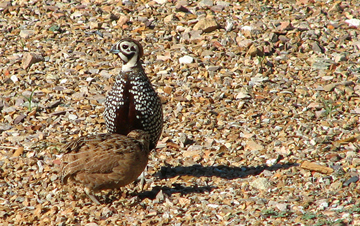
Montezuma Quail are regular late summer and occasional winter visitors. This pair was photographed from the house as they scratched in gravel just outside the back door (25 July 2006).
.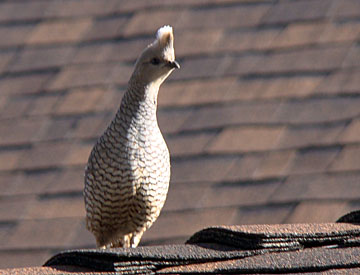
Scaled Quail occur in grasslands nearby but it was nine years before one ventured into the yard. Here a wanderer surveys the neighborhood from the roof (26 March 2013). A second male occurred during spring of 2021.
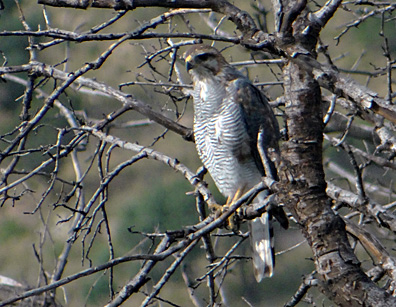
Attesting to the local nesting success of Gray Hawks, after nearly 12 years of seeing none in the yard, we saw three different birds in about three weeks. This one was found on 18 July 2015.
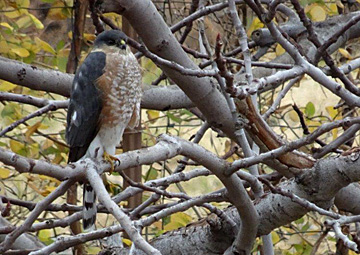
This dainty Sharp-shinned Hawk dropped into our fig tree to check our the various sparrows feeding below (Karen LeMay photo: 21 December 2016).
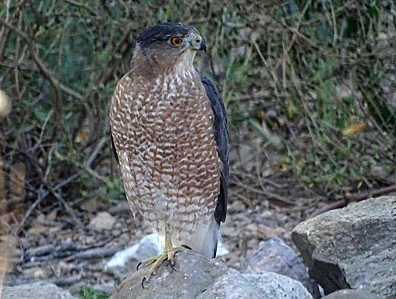
An adult Cooper's Hawk, perhaps one of the neighborhood's nesting birds, pauses at the edge of the pond while hunting in the back yard (5 November 2020).
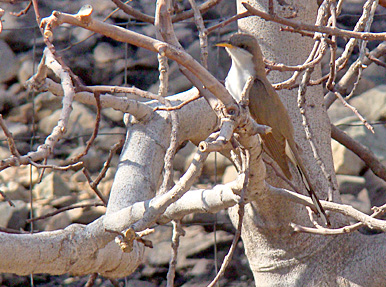
As is the case with Gray Hawk, Yellow-billed Cuckoo is more likely to be seen along the San Pedro River or in a similar riparian area. Most years, we get a cuckoo in the yard and they are often vocal. This one is sitting in our fig tree (28 June 2011).
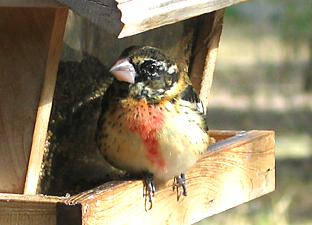
This male Rose-breasted Grosbeak was an unexpected winter visitor (13 January 2007).
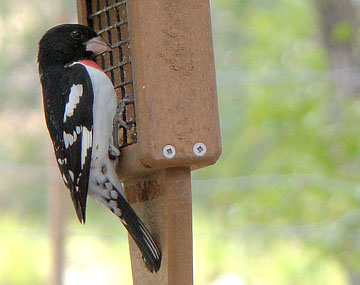
A much flashier male Rose-breasted Grosbeak showed up at suet on 1 May 2010 and remained for three days.
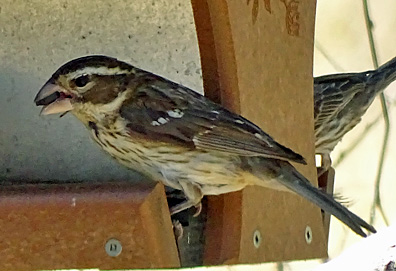
More subtle was this female Rose-breasted Grosbeak that visited feeders and the pond for several days during May 2021 (15 May).
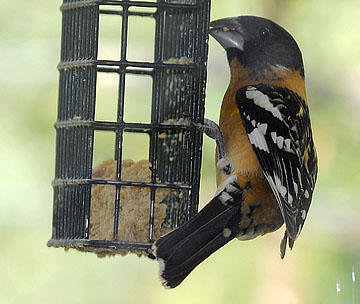
Black-headed Grosbeak is a common spring migrant. During a good migration, upwards of 20 may be present in the yard at once. They happily eat black sunflower seeds, home-made suet cakes, and grape jelly (11 May 2007).
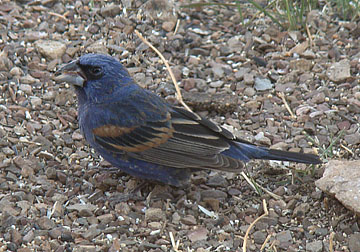
Blue Grosbeaks nest locally and we often have six or more around the yard. This male (above) came to seed outside the kitchen window (18 May 2011).
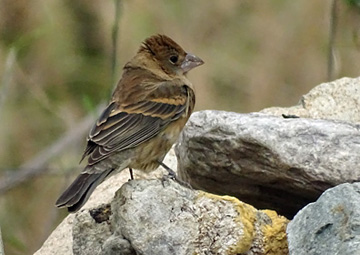
A female Blue Grosbeak comes in for a drink (21 May 2021).
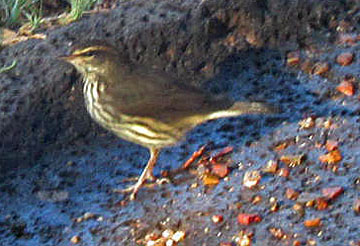
This Northern Waterthrush, one of the only "waterbirds" on the yard list, foraged just a few feet outside the back door (7 May 2012) (Photo by Karen LeMay).
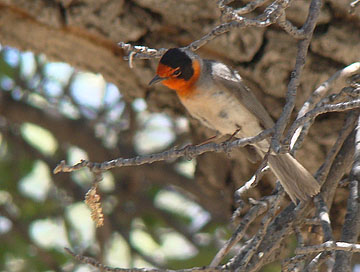
This was the third (of four) Red-faced Warblers to visit the yard. I was especially pleased to see it as I had missed the first two by being out of town (8 May 2011).
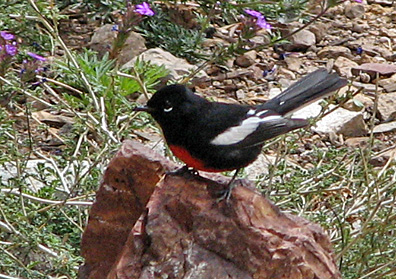
Although numerous in the canyons a mile or two from the yard, Painted Redstart is a sparse migrant here, always eliciting a bit of a celebration (19 March 2006).
An out of range Ovenbird forages in the butterfly garden (31 May 2006).

Several years later, another Ovenbird visited and stayed for most of the day (19 May 2009). (Karen LeMay photo).
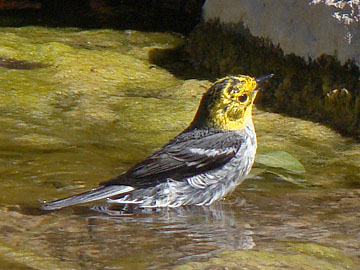
Hermit Warblers show up occasionally. This one dropped in for a bath on 3 May 2010.
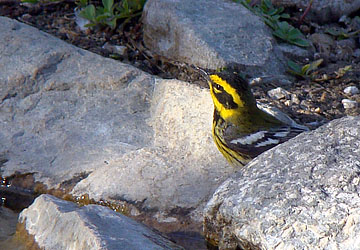
A fine male Townsend's Warbler (one of perhaps five that visited the yard that day) takes a drink at the pond (6 May 2011).
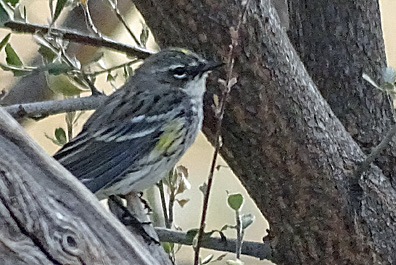
Barely annual in the yard, a "Myrtle" race of Yellow-rumped Warbler came in for a long bath at the pond (7 November 2020).
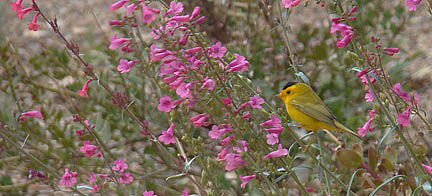
A male Wilson's Warbler catches insects in Penstemons outside the back door (9 April 2011).
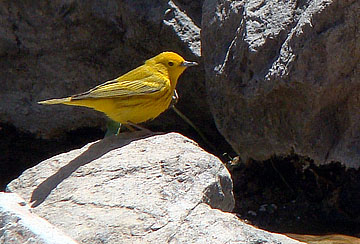
This male Yellow Warbler dropped in for a bath during spring migration (5 May 2011).
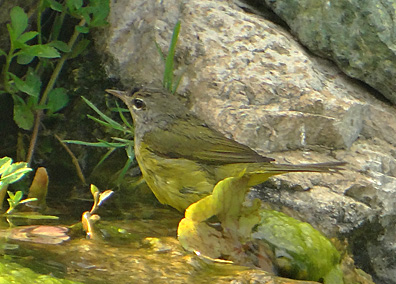
During August and September of 2015, we had multiple MacGillivray's Warblers many days. This one took a bath on 2 September.
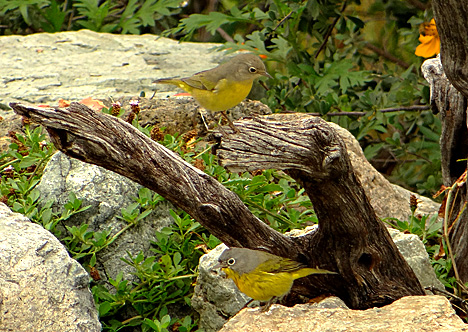
Nashville Warbler is a common local migrant. Here, two come to the pond for a dip (22 September 2015).
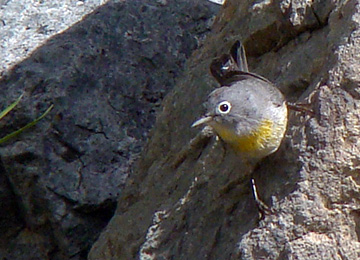
Virginia's Warbler is a sparse yard migrant that nests on nearby brushy, mountain slopes. Here, one comes to the pond for a drink (23 April 2010).
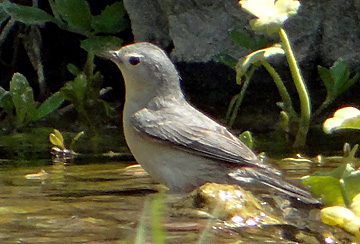
At 5,000 feet, we are about as high in elevation as one might expect Lucy's Warblers. Apparently, a pair or two nest locally, as we hear them singing throughout the spring (27 April 2015).
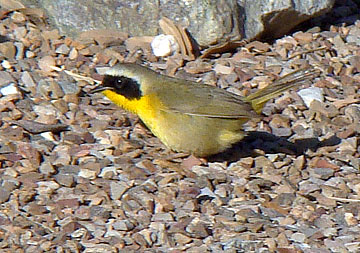
Far from any marsh or riparian area, our yard is poor habitat for a Common Yellowthroat. Here, a migrating male investigates the gravel for bugs (6 May 2011).
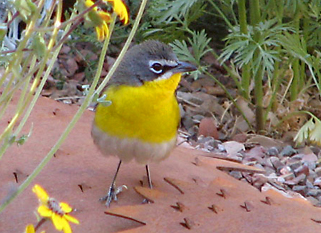
A splendid Yellow-breasted Chat photographed by Karen through the kitchen window (6 May 2007). Some individuals linger for several days and sing in the yard.
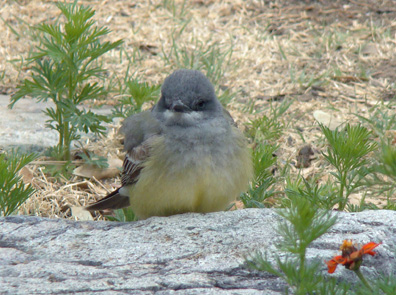
Cassin's and Western Kingbirds both nest in the neighborhood, occasionally coming in for a drink. Here, a Cassin's checks out the pond (9 April 2011).
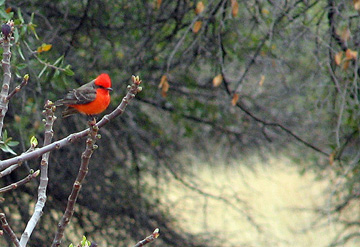
Vermilion Flycatcher is an unpredictable visitor; our first was during a blizzard. This male showed up 26 March 2006.
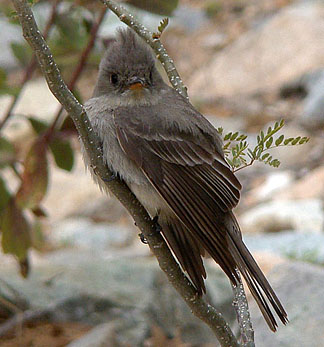
One of two Greater Pewees that showed up in the yard on an unseasonably cold afternoon (30 April 2010). Our next record was a singing bird 27-28 April 2021.
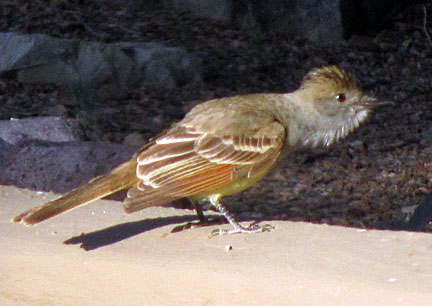
All three SE Arizona Myiarchus flycatchers occur in our yard. Here Karen shot a Brown-crested Flycatcher as it reacted to the presence of a Canyon Towhee on its turf. (21 May 2013). Often, they patrol hummingbird feeders attempting to prey on the hummers.
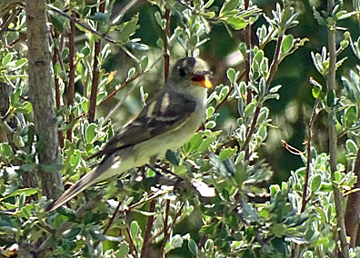
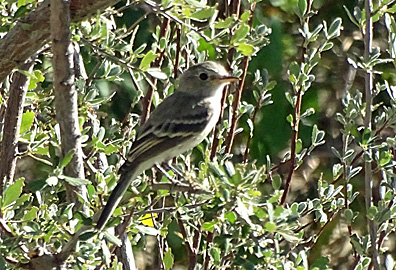
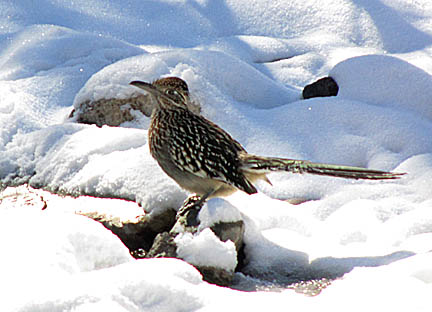
Despite their comical behavior, Greater Roadrunner is one of our least favorite yard birds, taking a terrible toll on "our" butterflies, and reptiles--even catching sparrows and hummingbirds. Karen photographed this one through the kitchen window on a snowy morning as it drank at the beach of our pond (21 February 2013).
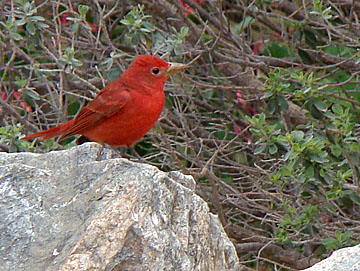
More likely to be seen in cottonwoods along the San Pedro River, Summer Tanager is an infrequent visitor to the yard (22 April 2010).
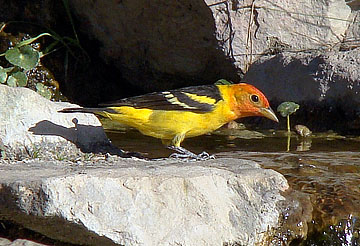
Western Tanager is a common spring migrant and we may see a dozen or more at a time-especially when there's fruit on the fig tree. This male, one of about eight present, took a drink and a bath at the pond (7 May 2011).
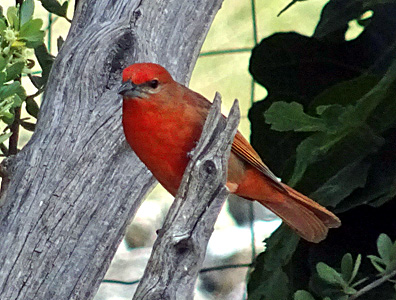
We see Hepatic Tanagers perhaps a couple times a year. This male visited the pond (8 May 2017).
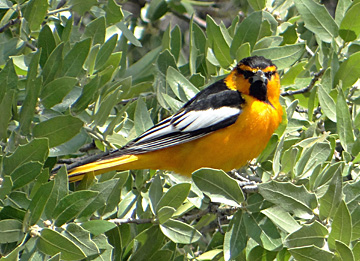
Three species of orioles visit us during spring and summer, providing plenty of color and song. They feed on suet cakes, sugar water, and grape jelly we provide, take nectar from ocotillo, desert willow, honeysuckle, and other blossoms, and hunt for insects in foliage. This male Bullock's Oriole was foraging in an Emory Oak (27 April 2015).
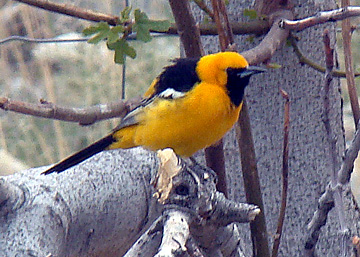
A male Hooded Oriole perches in our fig tree (14 April 2012).

Scott's Oriole is the most common oriole that visits the yard; six or more may be present at once. This male is acquiring its adult plumage (23 May 2016).
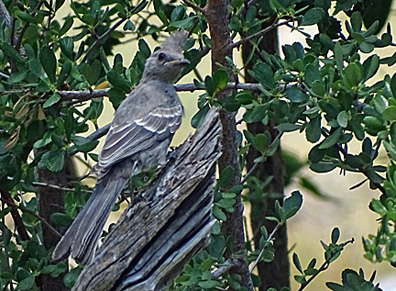
During summer, we often see Phainopeplas in the yard-often in family groups. This one dropped in for a bath on 23 June 2017.
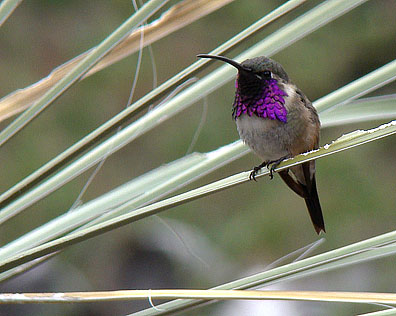
Lucifer Hummingbird is an exceedingly local U.S breeder. Happily, several pairs (apparently) nest in our neighborhood. Here, a male perches on a yucca leaf (23 April 2010).
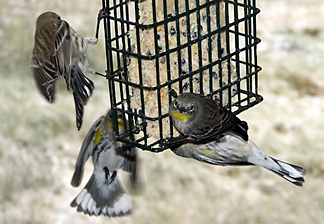
These Yellow-rumped Warblers are clustered at a suet cage while 20 more wait their turn (28 December 2006).
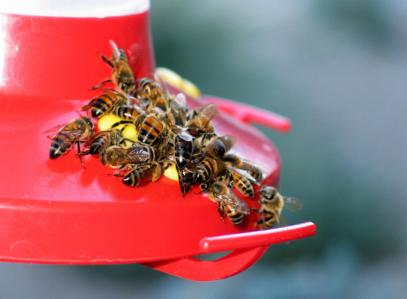
Morning rush hour (24 July 2006).
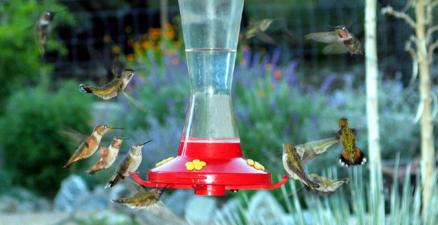
Afternoon rush hour (13 September 2004).
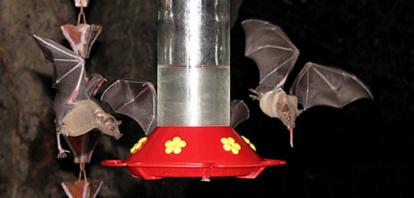
Evening rush hour (Lesser long-nosed bats) 17 Aug 2006.
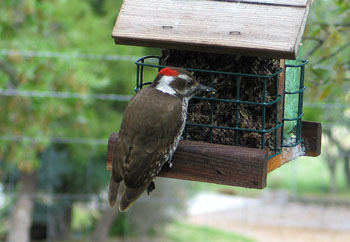
A male Arizona Woodpecker at suet outside a kitchen window (5 April 2004). Once regular, this species has been absent since the Monument Fire in 2011.
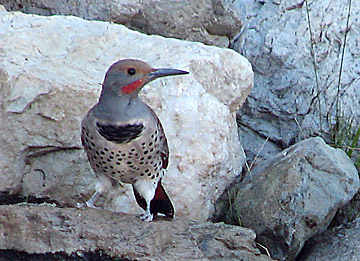
Above, a male Northern Flicker comes in for a bath (17 October 2009) (Karen LeMay photo); below a female, lacking the red moustache, gets a drink (13 November 2020).
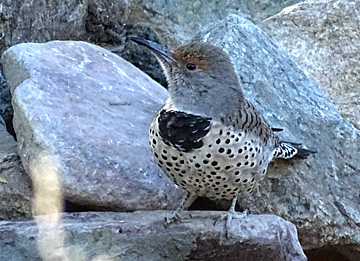
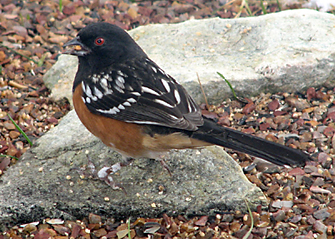
Spotted Towhee-one of our three winter towhees (13 February 2007).
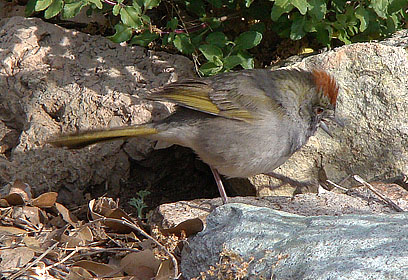
Green-tailed Towhee is one of our favorite yard birds. They are often absent during winter, showing up in April as they move northward (30 April 2010).
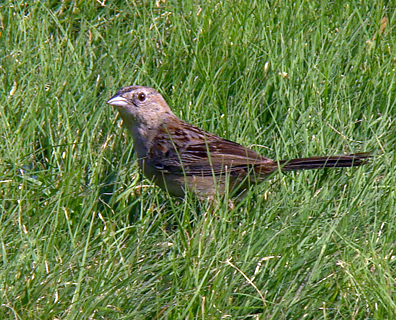
During previous years, Botteri's Sparrows had been audible just beyond the yard. In 2013, perhaps as a result of grassland responding to the Monument Fire, males were singing in the front and back yards and one or two individuals came to the pond. This increase had been noted by others in the neighborhood (12 August 2013).
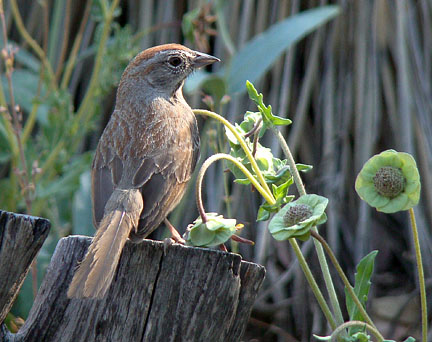
Rufous-crowned Sparrows are professional rocky slope birds and the hillside on Forest Service land behind the house serves them well. This one was visiting an irrigation drip head just outside the back door for a sip of water (5 June 2011).
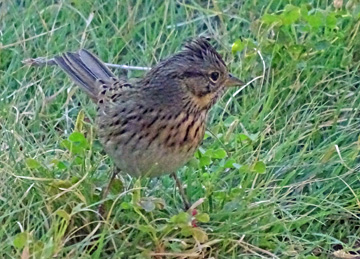
One or two Lincoln's Sparrows stay with us each winter, usually buried in foliage. This one foraged in grass just outside the kitchen window (27 September 2020). During February 2021, 11 were visible at once and numbers stayed high for several days.
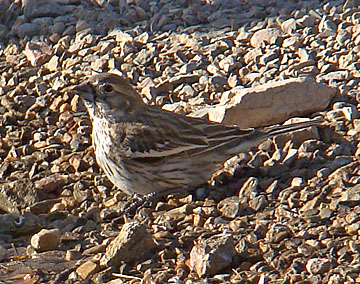
During winter, Lark Buntings are present by the thousands not far to the east of us. This was one of several that came to the pond with Vesper Sparrows (11 March 2012).
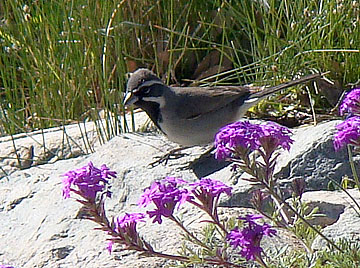
Although they nest not too far from the house, Black-throated Sparrow is a rare visitor to the yard. This adult appeared several times during May of 2011 (3 May 2011).
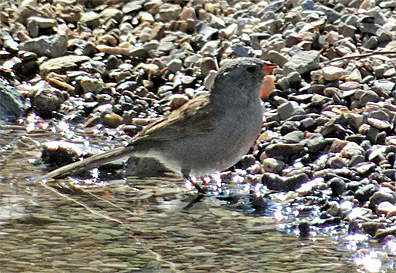
Black-chinned Sparrow occurs on brushy slopes less than half a mile from our property. Nonetheless, it took 17 years for me to see one in the yard, although Karen had seen one several years earlier (29 October 2020, Karen LeMay photo). During April 2021, an adult (below) appeared at the pond several times, suggesting nesting nearby (28 April 2021). Note the superficial similarities between Black-chinned Sparrow and the "Gray-headed" Dark-eyed Junco just below.
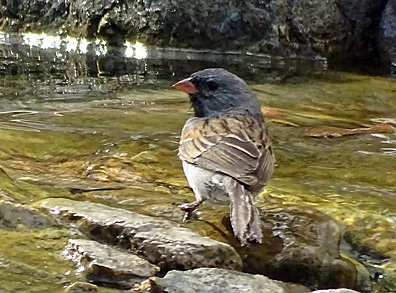
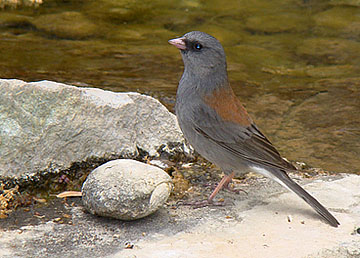
"Gray-headed Junco," one of five races of Dark-eyed Junco that have occurred in the yard (20 April 2010).
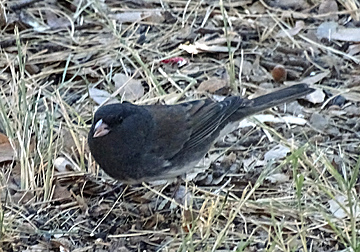
The Cassiar form of Dark-eyed Junco is this species' least-understood race and rather uncommon in SE Arizona. It has a better-defined hood than "Slate-colored" Junco (below) and a brownish back. (28 October 2020)
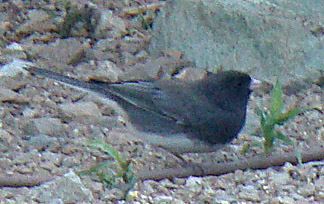
An Eastern "Slate-colored" form of Dark-eyed Junco that visited us on 14 November 2012.
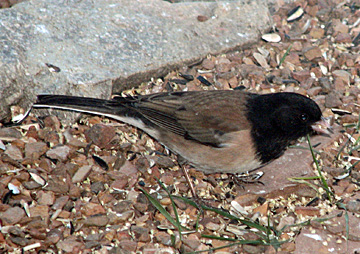
A dapper "Oregon Junco" at seed (22 January 2008).
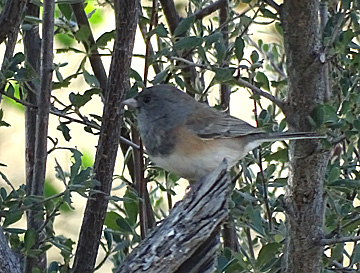
A "Pink-sided Junco" was one of two visiting the pond (12 October 2020).
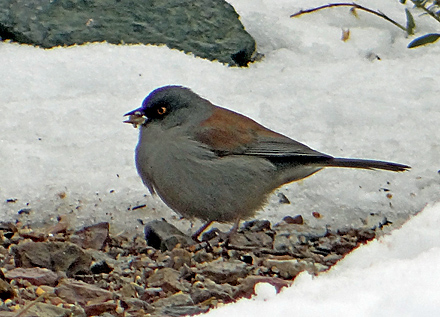
Yellow-eyed Junco is rather rare in the yard, occurring well less than annually. Likely the hardest snows on the ridges above us are responsible for their presence here (8 January 2016).
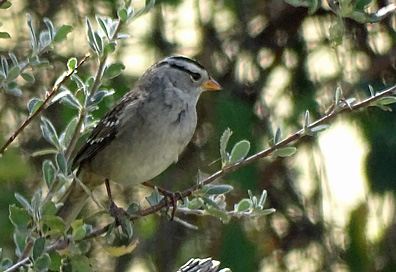
Variously sparse or numerous, White-crowned Sparrows visit throughout much of the year. Both pale (above 25 September 2020) and dark-lored forms (below 3 June 2020) occur.
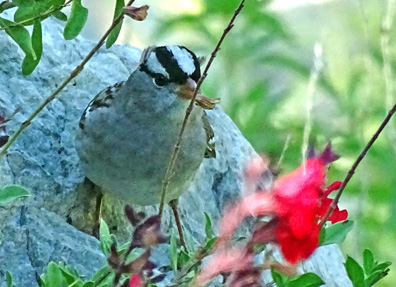
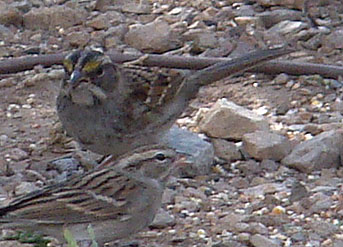
Although present now and then in the neighborhood, it took nine years for a White-throated Sparrow to visit our yard (21 November 2012). A second bird showed up during the last week of May 2020.
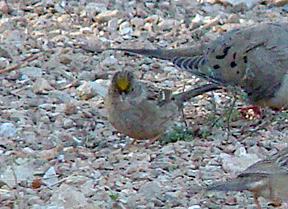
A Golden-crowned Sparrow found in the yard by Linda Feltner was a nice addition to the 2009 Ramsey Canyon Christmas Bird Count (19 December 2009).
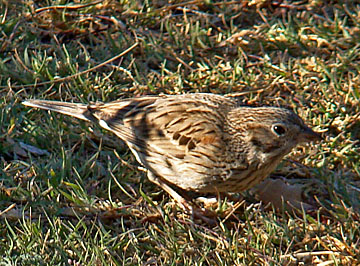
One of about a dozen Vesper Sparrows foraging on the grass outside the kitchen window (6 March 2012).
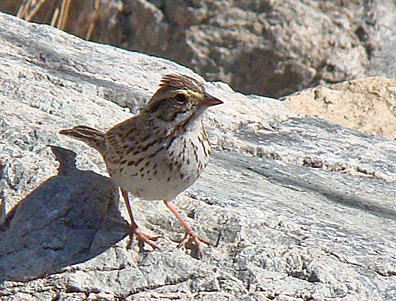
Savannah Sparrow is unusual in the oaks. We have seen one or two over the years, always at the pond (22 March 2012).
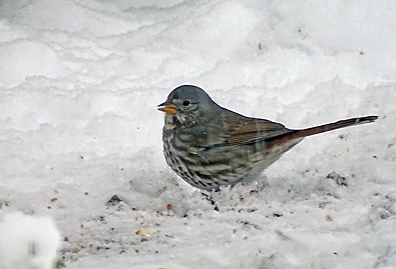
We've had one Fox Sparrow and it was a long time coming. Here it's eating seeds tossed on fresh snow (2 January 2019.
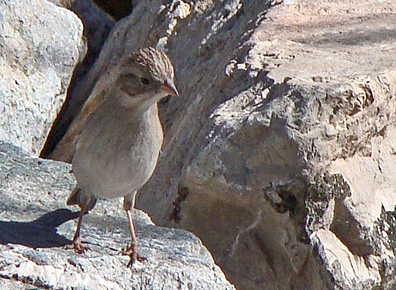
Brewer's Sparrows occur in small numbers; we don't see them every winter (22 March 2012).
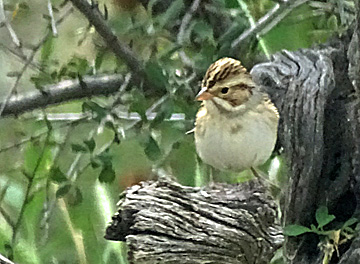
This Clay-colored Sparrow appeared for a short time on 14 September 2020.
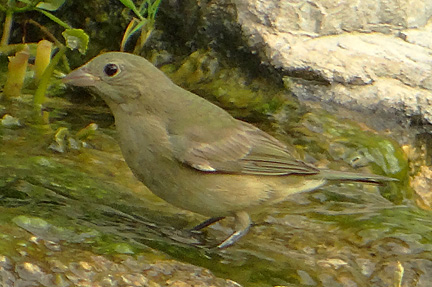
Painted Buntings have occurred in the yard perhaps eight times, generally in immature or female plumage (13 August 2015).
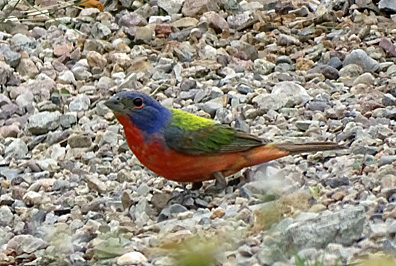
This male Painted Bunting lit up the pond area for a couple days (20 July 2020).
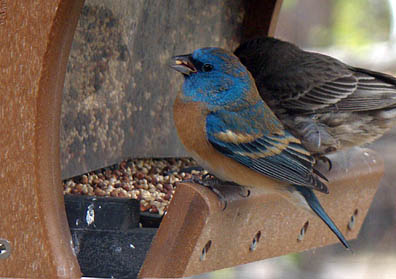
A male Lazuli Bunting, one of about 15 in the yard then, visits a feeder (9 April 2011).
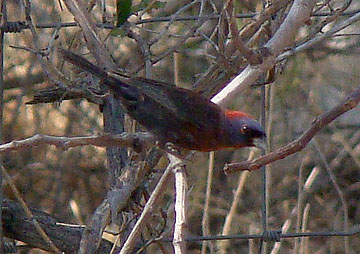
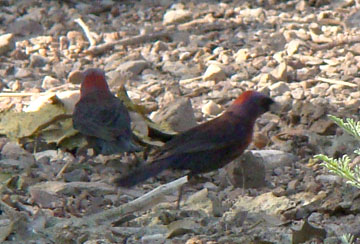
Varied Buntings seem to be more common, perhaps nesting nearby. Two males were quite unexpected (both photos taken 5 June 2011).
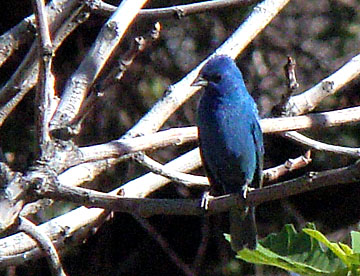
Indigo Buntings are sparse migrants through the yard, occurring less than annually. Here, a male dropped in for a drink (19 May 2012).
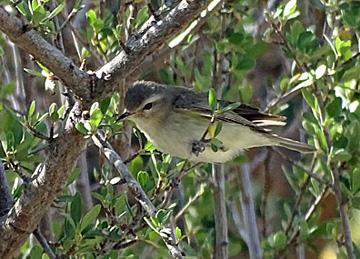
Warbling Vireo occurs during spring and the monsoon, perhaps nesting locally. They always seem nervous at the water feature. This one was seen 25 April 2021.
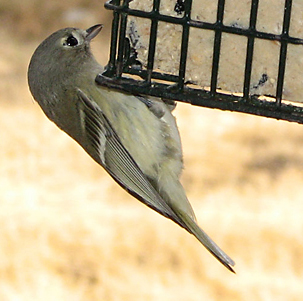
Hutton's Vireo is a species often associated with oaks. Here, one feeds at our homemade suet cakes (21 January 2007).
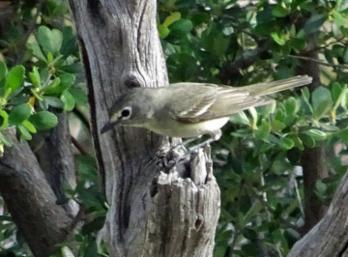
Cassin's Vireo is occasional at our pond; we see perhaps one or two per year. Karen photographed this one as it dropped in for a bath (10 April 2017).
-- MORE PHOTOS BELOW LIST--
Yard List: Forever a Work in Progress
NOVEMBER 2003 Canyon Towhee Mourning Dove Mexican Jay Spotted Towhee Bewick's Wren Chipping Sparrow House Finch Lesser Goldfinch Bridled Titmouse Acorn Woodpecker Northern Flicker Gila Woodpecker Ruby-crowned Kinglet Red-tailed Hawk White-breasted Nuthatch Cooper's Hawk Rufous-crowned Sparrow Pyrrhuloxia Anna's Hummingbird Cactus Wren Red-naped Sapsucker House Sparrow Lark Sparrow Yellow-rumped Warbler Cedar Waxwing Chihuahuan Raven Ladder-backed Woodpecker Say's Phoebe Greater Roadrunner White-winged Dove Arizona Woodpecker Verdin White-crowned Sparrow Williamson's Sapsucker Cassin's Kingbird Bushtit Hutton's Vireo Hermit Thrush Curve-billed Thrasher DECEMBER 2003 Vesper Sparrow Steller's Jay Savannah Sparrow Magnificent Hummingbird Black-throated Gray Warbler Phainopepla Sharp-shinned Hawk JANUARY 2004 Gambel's Quail FEBRUARY 2004 Northern Mockingbird Black Phoebe #50 Vermilion Flycatcher MARCH 2004 Violet-green Swallow Rufous Hummingbird Lewis's Woodpecker White-throated Swift Broad-tailed Hummingbird Black-chinned Hummingbird Broad-billed Hummingbird Lucy's Warbler Turkey Vulture Hepatic Tanager Common Poorwill Scott's Oriole Bullock's Oriole Elf Owl Virginia's Warbler Hooded Oriole APRIL 2004 Dusky Flycatcher Lazuli Bunting Costa's Hummingbird American Robin Ash-throated Flycatcher Blue-gray Gnatcatcher Orange-crowned Warbler Calliope Hummingbird Cassin's Vireo Lucifer Hummingbird Dusky-capped Flycatcher Wilson's Warbler Barn Swallow Western Kingbird Rock Pigeon Bronzed Cowbird Brown-headed Cowbird Black-headed Grosbeak Common Raven Peregrine Falcon Northern Rough-winged Swallow Eurasian Collared-Dove MAY 2004 Wild Turkey Brown-crested Flycatcher Western Tanager Warbling Vireo Great Horned Owl Red-winged Blackbird Blue Grosbeak JUNE 2004 Montezuma Quail Zone-tailed Hawk Sulphur-bellied Flycatcher Band-tailed Pigeon #100 Common Nighthawk
Yellow-billed Cuckoo Western Screech Owl Common Ground-Dove Violet-crowned Hummingbird AUGUST 2004 Painted Bunting Nashville Warbler Western Wood-Pewee Botteri's Sparrow Yellow Warbler #110 Canyon Wren MacGillivray's Warbler "Western" Flycatcher Summer Tanager Continued above on right (These columns will never even out.) | SEPTEMBER 2004 Plumbeous Vireo Lincoln's Sparrow American Redstart (!) Inca Dove Varied Bunting OCTOBER 2004 Lawrence's Goldfinch #120 Northern Cardinal Yellow-breasted Chat Pine Siskin Dark-eyed Junco DECEMBER 2004 Western Bluebird JANUARY 2005 Ruddy Ground-Dove (!) American Goldfinch MARCH 2005 Cassin's Finch APRIL 2005 Rose-breasted Grosbeak Green-tailed Towhee #130 Hermit Warbler Townsend's Warbler Gray Flycatcher Red-faced Warbler MAY 2005 Indigo Bunting JULY 2005 Bell's Vireo Swainson's Hawk SEPTEMBER 2005 Vaux's Swift Brewer's Sparrow House Wren OCTOBER 2005 #140 Blue-throated Hummingbird Rock Wren NOVEMBER 2005 Northern Harrier Winter Wren Brown Thrasher (!) DECEMBER 2005 American Kestrel MARCH 2006 Painted Redstart MAY 2006 Eastern Bluebird Ovenbird (!) JULY 2006 Aztec Thrush (!) AUGUST 2006 #150 Cassin's Sparrow SEPTEMBER 2006 Buff-breasted Flycatcher JUNE 2007 Yellow Grosbeak (!) SEPTEMBER 2007 Golden Eagle Black-throated Sparrow AUGUST 2008 Orchard Oriole Osprey MAY 2009 Swainson's Thrush SEPTEMBER 2009 Common Yellowthroat OCTOBER 2009 Lesser Nighthawk DECEMBER 2009 #160 Golden-crowned Sparrow (!) JANUARY 2010 Townsend's Solitaire FEBRUARY 2010 Yellow-eyed Junco MARCH 2010 Woodhouse's Scrub-Jay APRIL 2010 Hammond's Flycatcher Greater Pewee OCTOBER 2010 Black-throated Blue Warbler (!) APRIL 2011 Black-chinned Sparrow MAY 2011 Olive-sided Flycatcher AUGUST 2011 Plain-capped Starthroat (!) FEBRUARY 2012 #170 Western Meadowlark MARCH 2012 Lark Bunting Merlin MAY 2012 Northern Waterthrush (!) SEPTEMBER 2012 Belted Kingfisher OCTOBER 2012 Rufous-backed Robin (!) NOVEMBER 2012 White-throated Sparrow MARCH 2013 Scaled Quail DECEMBER 2014 Loggerhead Shrike JULY 2015 Gray Hawk OCTOBER 2015 #180 Green Heron FEBRUARY 2016 Elegant Trogon May 2016 Black-and-white Warbler (!) Yellow-throated Warbler (!) Gray Catbird (!) OCTOBER 2016 Eastern Meadowlark JULY 2017 Allen's Hummingbird AUGUST 2017 Tree Swallow DECEMBER 2017 Northern Pygmy-Owl JULY 2018 Great Blue Heron (fly-by) DECEMBER 2018 #190 Fox Sparrow APRIL 2020 Flame-colored Tanager (!) MAY 2020 Hooded Warbler (!) AUGUST 2020 Willow Flycatcher SEPTEMBER 2020 Clay-colored Sparrow Thick-billed Kingbird NOVEMBER 2020 Crissal Thrasher DECEMBER 2020 Mountain Bluebird APRIL 2021 Common Black Hawk |
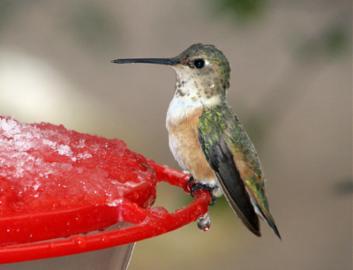
Rufous Hummingbird on a snowy feeder (19 March 2006).
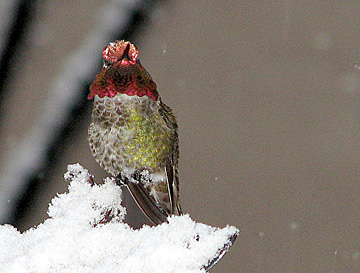
A male Anna's Hummingbird flashes me during a snow flurry (19 March 2006).

Violet-crowned Hummingbirds now occur annually, showing up at feeders and flowers we have planted (13 July 2011).
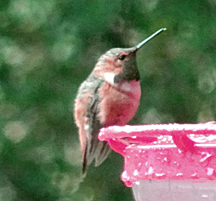
A male Allen's Hummingbird, the 13th hummingbird for the yard. The tail feathers were measured several days later (Karen LeMay photo, 21 July 2017).
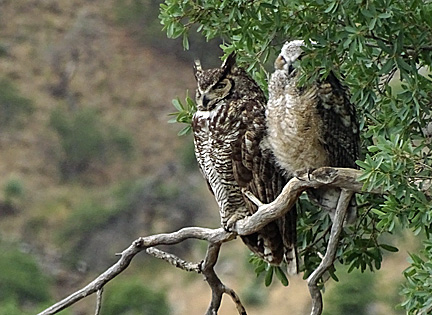
Great Horned Owls nest in the neighborhood and are a favorite target of Mexican Jays that harass them mercilessly. Here an adult and a fledgling bask in the sun before being driven into cover by jays (1 July 2019).
One of a pair of Elf Owls that nested in our driveway utility pole (27 Mar 2004).
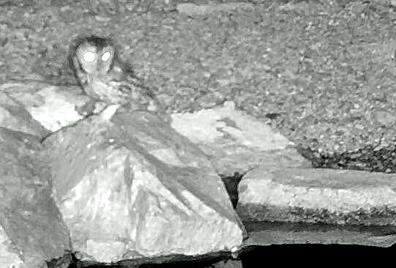
Western Screech-Owls are locally common nesters. This is a greatly cropped screen shot of one that sat for a minute or so at our pond and was videotaped by a trail camera (3 November 2020).
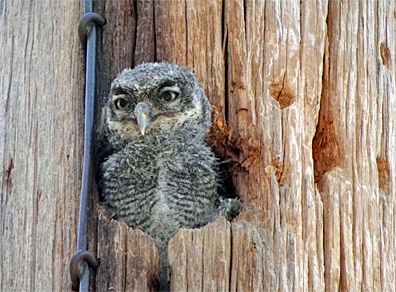
A Western Screech-Owl nestling peering from the nest hole in the old power pole just outside our bedroom window (15 June 2021, Karen LeMay photo).
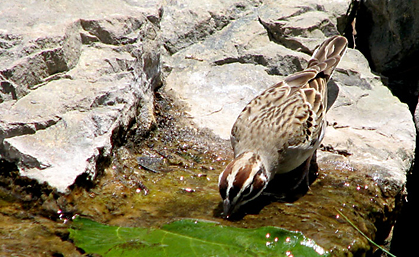
Lark Sparrows are with us pretty much year 'round. Here, one pauses for an afternoon sip at the pond (7 May 2007).
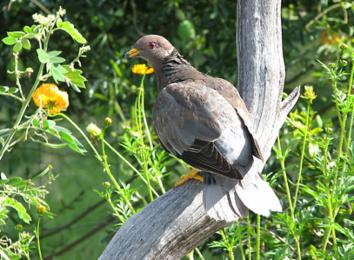
A Band-tailed Pigeon in the garden (6 September 2006). Numbers of them visit the yard to feed on acorns.

Montezuma Quail forage in monsoon green Bermuda grass (subsequently replanted) outside the kitchen window (15 July 2004).
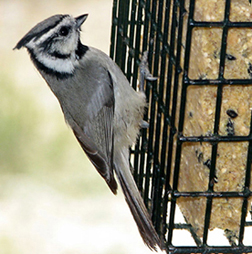 | 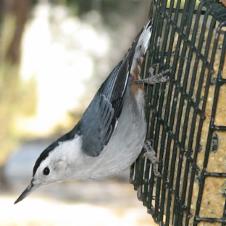 |
A Bridled Titmouse, one of our favorite birds, investigates a suet cake (19 Dec 2006). | This White-breasted Nuthatch dines at suet (20 Dec 2006). |
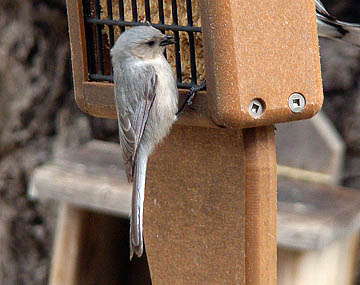
A Bushtit grabs a mouthful of suet cake (9 April 2011).
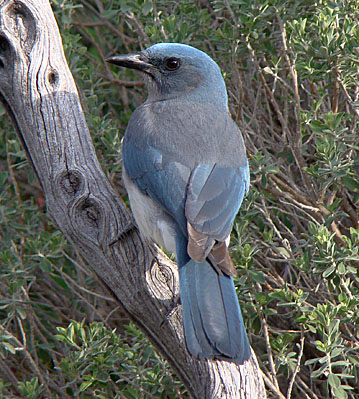
Mexican Jays are a raucous element of the neighborhood avifauna. Expect them to eat more than their share of seed and suet cakes. In return, they are an excellent rattlesnake alarm system. (30 April 2010).
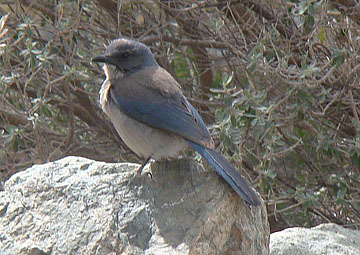
Although frequently present less than a mile from our house, it was more than six years before we saw a Woodhouse's Scrub-Jay in the yard (31 March 2010).
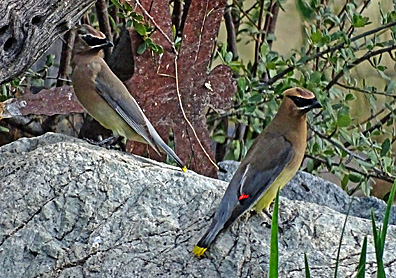
Cedar Waxwing is quite uncommon in the yard-perhaps less than annual. Here, a small flock visited the yard and several dropped in for a bath (19 October 2020).
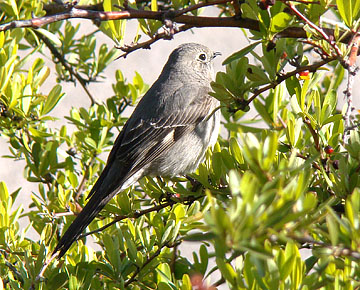
This Townsend's Solitaire stayed for several months and was a faithful visitor to berries on our Pyracantha shrubs. Before departing, it spent many days singing its lispy, thrasher-like song (6 April 2010).
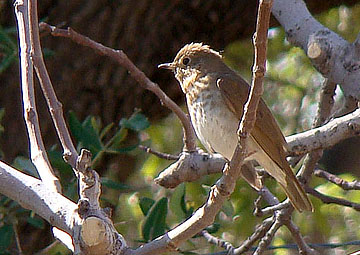
Swainson's Thrush is less than annual in the yard. Several appeared during the first week of May in 2011, one of which left an attacking Roadrunner with a mouthful of tail feathers (3 May 2011).
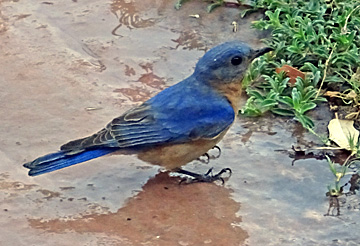
An Eastern Bluebird of the Mexican subspecies fulva, sometimes called Azure Bluebird, takes a shower by a sprinkler outside our back door (5 June 2016, Karen LeMay photo).
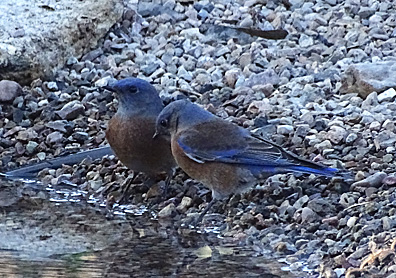
Western Bluebirds occur locally during winter. Here two (of five present) drop in for an early drink (5 November 2020).
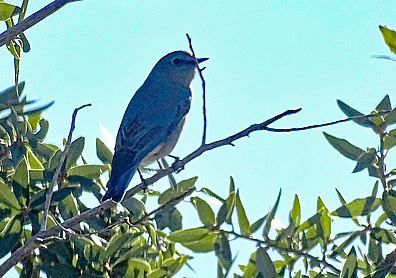
Two Mountain Bluebirds, our only record for the yard, visited the pond for a quick drink. Here is the male (13 December 2020).
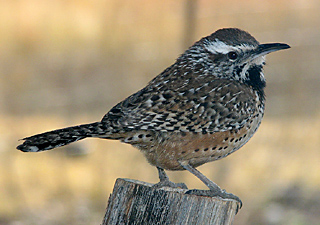
An icon of the Southwestern deserts, the Cactus Wren becomes less common as one ascends into the oaks. Here one waits its turn at a suet feeder (6 January 2008).
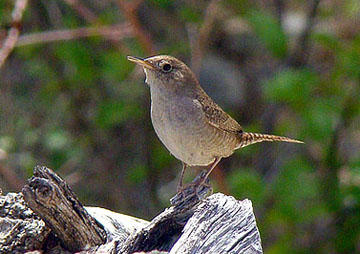
House Wren is an occasional visitor. This one, probably a migrant, was investigating a wood pile (20 April 2010).
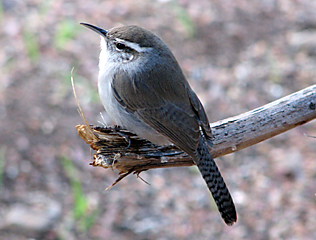
Bewick's Wrens entertain us throughout the year, investigating every nook and cranny on the house and all of our trees. Here one sits on an agave perch outside the kitchen window (13 February 2007).
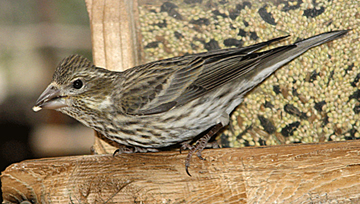
Cassin's Finch is a less than annual visitor. Here, a female briefly joins the feeder flock (14 January 2008).
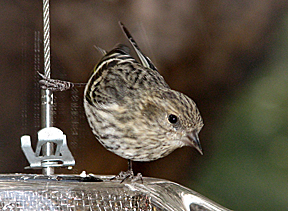
During various winters, Pine Siskins may be nearly absent or present by the dozens (23 January 2008).
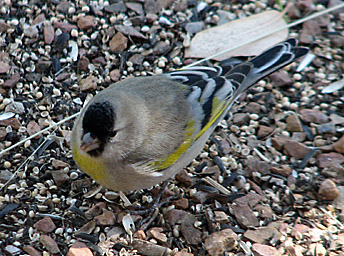
Lawrence's Goldfinches appear in the yard some years. This was one of two males that visited the pond then fed below the kitchen window (23 October 2009).
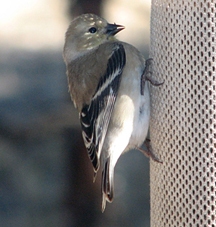
American Goldfinches are rare guests. One feeds at a thistle sock (29 January 2008).
Robert A. Behrstock 2022
Images may not be reproduced without the Photographer's permission.
